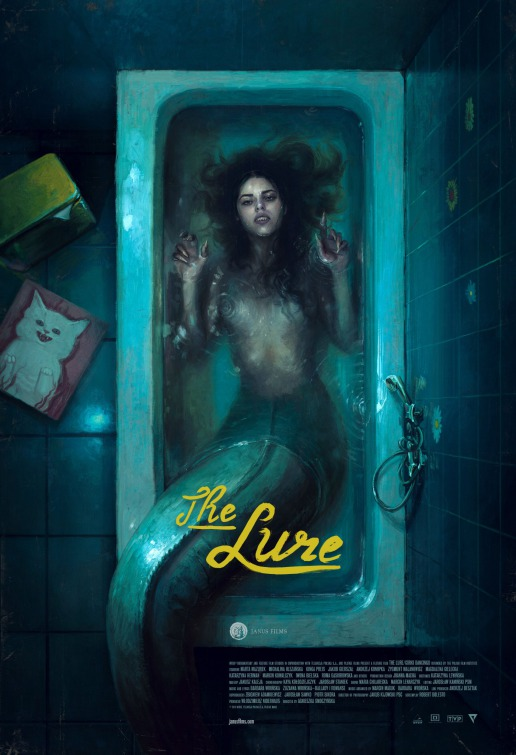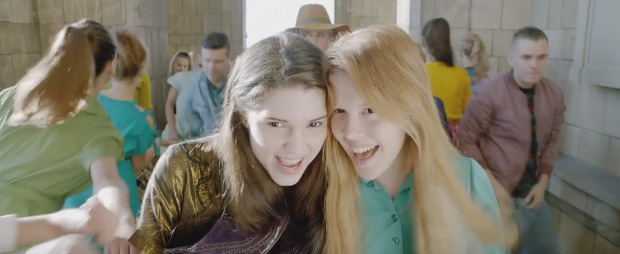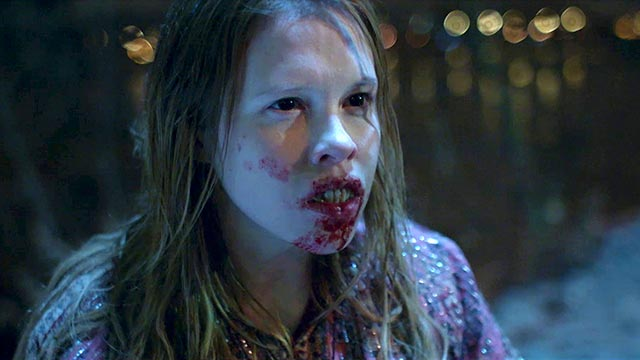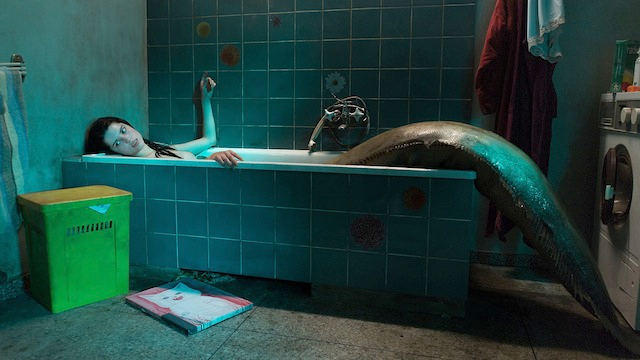THE LURE Review

Director: Agnieszka Smoczyńska
Genre: Musical, Comedy, Horror
Year: 2015
I seem to find myself watching a lot of offbeat foreign films, and THE LURE, aka CORKI DANCINGU, feature-length debut of Polish director Agnieszka Smoczyńska, certainly fits those parameters. Both a coming-of-age story and sort-of comedy, sort-of horror musical about two man-eating mermaids who wind up as performers at a seedy nightclub, it is sure to appeal to those with a taste for the bizarre. Originally released in Poland in December of 2015, THE LURE played at Sundance in 2016, and properly lands in North America on February 1st, 2017.
THE LURE opens on a group of people playing music on a beach where, by chance, two mermaids are passing en route to America. Hearing the music, the mermaids — sisters Silver (Marta Mazurek) and Gold (Michalina Olszańska) — appear before them, joining in song before coming ashore. However, it is the sisters who become entranced, mesmerized by the glitz, glam, and what they hope will be their shot at making it in a big, new world.

Selfie
Although its premise seems one-of-a-kind, THE LURE is really just a modern retelling of “The Little Mermaid” (We’re talking the deeply melancholic 19th century poem, not the Disney version with singing crabs.) In repurposing Hans Christian Andersen’s tale for its plot, and in using literal mermaids, THE LURE is able to explore, or at least camouflage, the tired coming-of-age themes of innocence lost and heartbreak in a clever way, while addressing the more taboo topics of bodily development, shame, and the sexual missteps of adolescence. And, true to musical form, much of this is done through song and dance. However, perhaps the strongest aspect of THE LURE is that, while a faithful retelling of “The Little Mermaid,” it is also a sly reinterpretation, inverting several elements of the classic to further its themes. This is most readily apparent in the mermaids themselves, sisters Silver and Gold.
Silver and Gold are young and beautiful, yes, but though they give every appearance of it, they are not the beguiling nymphs centuries of tall-tales have made us come to expect. In actuality, Silver and Gold are fanged, serpentine monsters who magically grow legs when dry, regrowing their tails when wet (They also happen to eat people, which doesn’t ever really become as important as you’d think.) Even though they are able to appear human, the girls never quite fit in, and their transformations disgust those closest to them. Not quite children, not even close to being women, and transitioning through something seen by many as repulsive, they find themselves unwanted, with no real place in the world.

Should have swiped left, bro
If the mermaids of THE LURE are a far-cry from what most people are familiar with, the men are no Prince Erics either. THE LURE’s male characters are, almost exclusively, played up as either horny idiots or complete sleazebags seeking to exploit Silver and Gold physically or for profit. On one end of this, we have the token love interest, who is so clueless he isn’t even sure if he actually likes Silver or if he just wants to sleep with her. On the other end, we have the club owner, who has the sisters strip nude within minutes of meeting them — and later, repeatedly, before a crowd as a part of their act. It’s all very poignant — or it could have been, had it actually committed to its explorations of femininity.
This is exactly the kind of movie one would expect to be brazenly subversive and transgressive, but it isn’t. Unlike other female-empowering horror films such as GINGERSNAPS and TEETH, THE LURE lacks bite. Every time it could — and should — push further, THE LURE relents and shifts gears (often to another scene entirely), resulting in a plot progression that isn’t whimsical so much as it is wishy-washy and ineffectual. By constantly shying away from the issues it so badly wants to discuss, THE LURE manages to negate what could be a pertinent feminist message. Worse still, the film even ends up pigeonholing the sisters into the same old, hackneyed tropes of (literal) man-eater and doe-eyed victim.

Is that a HAUSU reference on the floor, or am I just desperately grasping for enjoyment?
THE LURE is, in a word, unfocused. There is no logic here. Sure, a certain amount of goofiness is to be expected in a film like this, but THE LURE is all over the place. Hardly anything is defined (most characters aren’t even named), there is little development in the way of character and plot, and everything seems to occur in a vacuum, with no real sense of cause and effect. There aren’t even any real consequences for any of the killings that take place. It’s as if the film gambles its success on being as odd as possible, hoping to distract the viewer from noticing just how disjointed and vacuous it really is.
Despite having so much to work with, THE LURE fails to deliver on just about every front. It does excel as a musical — the songs are catchy and fun, and they convey the film’s coming-of-age themes in a succinct manner — but it isn’t funny, it isn’t scary, and it doesn’t have any real takeaway. Smoczyńska, with a unique opportunity to explore womanhood, lampoon misogyny, or at the very least make a unique, visual shocker, has created something more in line with the “get high and make a movie” aesthetic of Kevin Smith. Of course, those films do have an audience, and THE LURE will no doubt manage to hook a few viewers, but those looking for a thoughtful meditation or even just a fullbore, body horror gross-out ought to keep swimming.
Verdict: Do Not Recommend



